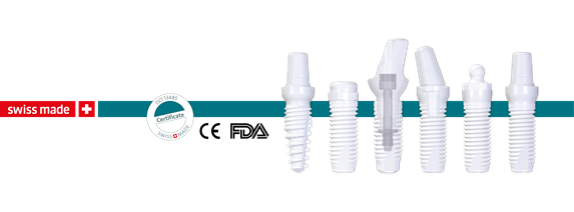Zirconia Dental Implants
Dr Scott Hamblin is a Salt Lake City Zirconia Dental Implant Specialist.

HOLISTIC & BIOMIMETIC DENTISTRY.
TITANIUM OR ZIRCONIA IMPLANTS
One of the most improved fields of dentistry is holistic and biomimetic dentistry. Biomimetic/holisitc dentistry involves treatment techniques designed to help you maintain healthy teeth with preventive measures to reinforce them, ultimately reducing the risk of future decay and the need for major dental work. Biomimetic literally means to copy what is natural. Biomimetic dentistry aims to copy your teeth’s natural processes using advanced technology, ultimately helping to:
- Protect against bacteria
- Reduce the risk of infection
- Prevent loss of teeth
- Reinforce the teeth so that dental work lasts longer
- Reduce the potential for decay and problems later in life that may require significant dental treatment
As people get older, their teeth tend to become more susceptible to serious dental issues that require crowns, root canals, or extractions and dental implants. Dr. Scott Hamblin, a dentist with offices in Sandy, Utah and Las Vegas, is using the latest biomimetic materials and techniques to help preserve and protect the natural structure of teeth and prevent the need for these more invasive procedures. Dr. Hamblin focuses on conserving and strengthening teeth that have become compromised by damage or decay with long-lasting results that look natural.
Dr. Hamblin feels that biomimetic materials have many advantages over traditional metal materials. In addition to having toxic mercury in your mouth, metal fillings can actually allow bacteria to re-enter the tooth cavity, cause more decay, or even lead to tooth loss. However, biomimetic fillings can bend and flex with the tooth, offering enhanced strength and protection.
As a holistic/biomimetic dentist, Dr. Hamblin uses biomimetic techniques to preserve as much of the patient’s natural tooth structure as possible when remedying substantial tooth decay. For example, using a fine fiber/kevlar mesh, he is actually able to line the tooth structure from the inside out for improved strength. Traditionally, a dental crown would be used to resolve this condition, necessitating that the tooth be filed down in order to properly receive the crown.
A general dentist spends his or her day drilling and filling teeth. When a cavity is found, this dentist will bring out the drill to remove the decayed tooth material, and fill that cavity with other material — sometimes with gold, porcelain, a composite resin, or an amalgam alloy of up to 50% mercury and a mix of other metals. A Holistic and biomimetic dentist like Dr. Hamblin practices dentistry in a very different way. Dr. Hamblin will often use Ozone to clean out and kill all bad bacterial found in a tooth with decay. Ozone is non-invasive and painless. Ozone and Kevlar are used in Biomimetic Dentistry. This approach saves natural tooth structure and mimics natures design. This is one of the reasons people travel from all over the world for treatment from Dr. Hamblin.
Ozone can be used in the following ways:
Cavity prevention: Ozone can be used just prior to filling a tooth, which disinfects it and minimizes recurrent decay. When the nerve of the tooth has been damaged by decay, ozone treatment can often minimizes the risk of nerve death, thus reducing the need for root canal or extraction.
Gum Disease/Infection: Because periodontal disease is an infection, ozone can be highly effective in treating this condition to help you keep your teeth and prevent systemic disease associated with gum infection.
Dental Surgery: Irrigation of the surgical site with ozone can dramatically speed healing and reduce the possibility of infection.
Zirconia Dental Implants Vs. Titanium Implants
Dental patients are becoming increasingly concerned with the materials coming into contact with their bodies and the impact this can have on their health. When placing dental implants, it is always ideal to use the least reactive and least toxic material possible. It is also important to evaluate the strength, clinical success, and other relevant factors of such materials.
Over the years, the trend has been towards avoiding putting metals in our body. An alternative material to titanium exists in the form of zirconia for dental implants. Health conscious patients frequently ask, “Are zirconia dental implants better than titanium?” The answer to this question is not simple, as it is important to understand the potential benefits, limitations, risks, and other factors.
What are zirconia implants
Dental implants are medical devices used to replace missing teeth. Since the 1960s, titanium implants have been the industry standard. With decades of clinical success and innovation, titanium implants have become one of the most successful medical devices in all of
Zirconia implants are an alternative to titanium implants. They were released in 1987 and have recently gained more attention along with holistic dentistry.
What are zirconia implants made of
Zirconia dental implants are typically marketed as a non-metal, “ceramic” material that is white in color like natural teeth and has all the same advantages as traditional titanium implants. Interestingly enough, Zirconium has an atomic number of 40 making it a transitional METAL. Zirconia implants come in the form of Zirconium Oxide (which is often referred to as Zirconia). Every ceramic has a crystal structure containing both metallic and non-metallic atoms, but the combination is never referred to as
Traditional Titanium implant surfaces are used in Titanium Oxide form, so why are they considered a metal? This is because titanium implants are a grey metal color and zirconia implants are white. The simple difference in color is one of the main reasons these implants were developed and have gained popularity from the general public. There are many claims of non-esthetic implant restoration caused by the grey color of the titanium implant. However, with proper placement through a 3D guided surgery protocol and utilizing white zirconia for the abutment material, we can repeatedly get highly-esthetic results for our patients.
Are zirconia dental implants better than titanium?
Studies have shown that titanium and zirconia implants have a very similar bone to implant contact. This is the amount of bone that is in contact with the implant and determines the stability of the implant in the patient’s mouth. s we discussed above, it is important to understand the potential benefits, limitations, risks, and other factors associated with zirconia implants. Here is what you need to know when deciding between zirconia and titanium dental implants:
- Titanium Allergies. Perhaps the biggest concern patients have is if they will be allergic to titanium. In fact, it is extremely rare for people to have a true allergy to titanium. Studies have shown an extremely low prevalence rate of 0.6% of patients being allergic to titanium. Patch tests have limited use due to poor sensitivity and the test validated to detect titanium sensitization is
MELISA test. This test has also been known to show false positives. - Zirconia implants usually cannot be left to heal under the gums. The process by which dental implant fixate to the bone is called osseointegration. This process usually takes about 6 months to complete. When dental implants are surgically placed, they must have a certain torque value or primary stability. Implants that do not have
a good primary stability need to be left to heal under the gums for 3-6 months following placement. Most Zirconia dental implants cannot heal under the gums because of their “one-piece” design, meaning that they do not have a removable abutment but one that is fixed to the implant. - Zirconia implants with a small diameter are prone to fracture. Zirconia Implants are more prone to cracking than titanium dental implants. As it was mentioned above, zirconia is very strong in compressive forces but somewhat brittle in elastic forces. It is for this reason that small diameter zirconia implants are contraindicated. Often times in implant dentistry, the dentist must utilize a small diameter implant in the range of 3.0mm-3.75mm due to thin bone or small spaces between the teeth
- Zirconia implants are more expensive than titanium implants (about $400 more)
- Full-mouth treatments are much more difficult with one-piece abutments. Many implant patients are missing all of their teeth or need all of their teeth replaced. This is a great way to restore confidence, chewing efficiency, and quality of life. Often times, this is life changing for dental implant patients. This type of treatment takes a great amount of planning and execution by the dentist to have superior esthetic and functional results. Custom abutments and screw-retained restorations are usually a requirement for full arch or full mouth implant treatment. Because of zirconia implants one-piece design, it makes it more complicated to do full mouth restorations, such as the ‘ALL-ON-4’
Conclusion on zirconia dental implants
Both titanium and zirconia are very bioinert materials, meaning that they do not cause local inflammation and are not rejected by the body. It is because of this reason that these are the two materials of choice for the abutment portion of the implant system. The abutment is the piece of the implant system that connects the dental crown or the tooth in the mouth to the implant that is in the jawbone. We do not have to use zirconia implants to achieve predictable, and natural-looking restorations. However, there are certain indications where zirconia implants can be used for patients that prefer zirconia over titanium. And that is the main reason we offer the Z-Systems zirconia implants.
Summary
Today, Titanium is not the only material manufactured for tooth implants and so it is important to be aware of all the options available to you. No matter what you are considering for dental implants, we can provide you with a comprehensive range of information. As a holistic/biomimetic dentist, our goal is to provide for our holistic dental patients, absolute metal-free restorative dentistry which not only includes zirconia implants, but crowns and bridges, pressed all-ceramic crowns, porcelain veneers as well as invisible tooth-colored fillings.
Ceramic options are proven holistic, aesthetic and hygienic over other their metal counterparts.
